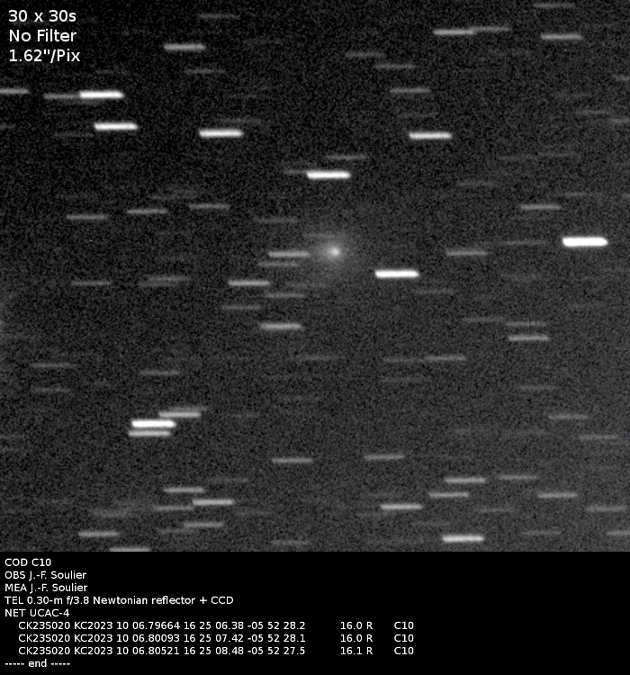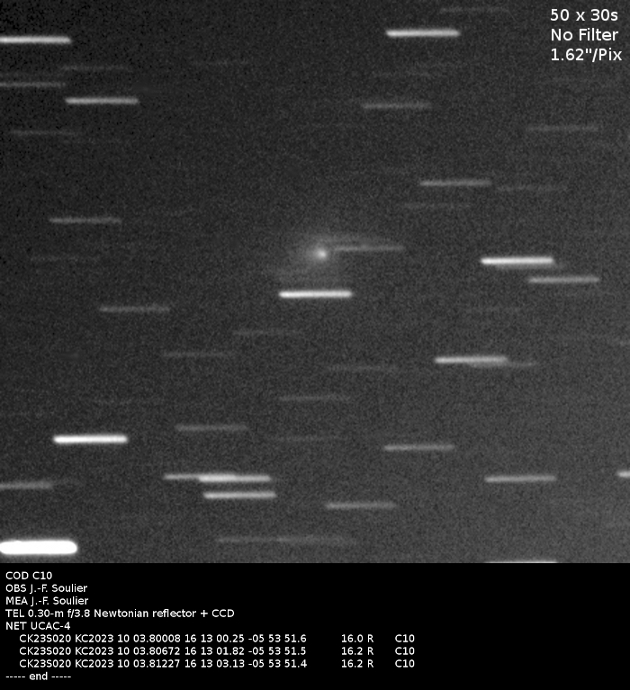
C 2023 S2 ATLAS



COMET C/2023 S2 (ATLAS)
P. Veres, Minor Planet Center, informs the Central Bureau that L. Denneau
has reported the discovery of a comet in survey images taken in the course of
the "Asteroid Terrestrial-Impact Last Alert System" (ATLAS) search program
on Sept. 29.0 UT with a 0.5-m f/2 Schmidt reflector at Rio Hurtado, Chile,
noting a diffuse 8".5 coma (cf. MPEC 2023-T5). The discovery observations
are tabulated below.
2023 UT R.A. (2000) Decl. Mag.
Sept.28.98636 15 54 22.83 - 5 53 57.3 15.1
28.98953 15 54 23.53 - 5 53 57.9 15.1
28.99819 15 54 25.48 - 5 53 58.0 15.2
29.00969 15 54 28.06 - 5 53 57.7 15.4
After the comet was posted on the MPC's PCCP webpage, numerous other CCD/CMOS
astrometrists have sent reports of cometary activity to the Central Bureau.
M. Mattiazzo (Swan Hill, Victoria, Australia) writes that stacked 120-s CMOS
exposures using a green filter taken on Sept. 30.0 UT with a 500-mm f/2.8
Takahashi Epsilon 180ED refractor located at Rio Hurtado Valley, Chile, show
a diffuse coma 70" wide of total V magnitude 13.2 (UCAC4 reference
stars). Ten stacked 30-s exposures taken on Oct. 1.4 by Mattiazzo using a
Celestron RASA 0.28-m f/2.2 astrograph at Swan Hill show a diffuse coma 2' in
diameter of UCAC4 V total magnitude 13.0. Twenty-four stacked 10-s CCD
exposures taken remotely on Sept. 30.0 by H. Sato (Bunkyo-ku, Tokyo, Japan)
with a "Deep Sky Chile" 0.51-m f/6.8 astrograph located at Rio Hurtado, Chile,
show a strongly condensed coma 40" in diameter with no tail; the magnitude was
13.8 as measured within a circular aperture of radius 20".2.
E. Guido (Castellammare di Stabia, Italy) writse that twenty stacked
unfiltered 60-s CMOS exposures taken remotely by M. Rocchetto, A. Valvasori,
and himself on Sept. 30.4 UT with a "Telescope Live" 0.10-m f/3.6 refractor
located at Yass, NSW, Australia show a coma about 80" in diameter.
A. Valvasori (Padulle, Italy) adds that eighty stacked unfiltered 30-s CCD
exposures taken by Guido and himself on Oct. 1.75-1.77 with a 0.30-m f/4
reflector at the ALMO Observatory in Italy show a coma about 37" in diameter
of mag 15.3-15.5.
L. Buzzi (Varese, Italy) relates that fifth-two stacked 30-s CCD
exposures taken with an R_c filter on Sept. 30.8 UT by A. Aletti (and measured
by Aletti and F. Bellini) with a 0.36-m f/7.5 reflector at Varese show a
moderately condensed coma 20" wide and a faint, straight tail 15" long toward
p.a. 115 degrees.
J.-F. Soulier finds a coma of size 42" in thirty 30-s unfiltered CCD
exposures taken on Sept. 30.8 UT with a 0.30-m f/3.8 Newtonian reflector at
Maisoncelles, France; the red magnitude was 16.2 in an aperture of radius
6".5. Eighty additional unfiltered 30-s CCD exposures obtained on Oct. 1.8
by Soulier using a 0.25-m f/3.5 Newtonian reflector located at Dauban, France,
show a 45" coma and magnitude 16.4 in an aperture of raidus 6".
T. Prystavski (Lyiv, Ukraine) reports a 2'.5 coma of total mag 12.7 and
no tail on CMOS images obtained on Oct. 1.0 UT with a "Deep Sky Chile" 0.18-m
f/2.8 hyperbolic astrograph located at Rio Hurtado.
J. J. Gonzalez Suarez (observing from Pandorado, Leon, Spain) writes
that he observed this comet visually in a very clear mountain sky on Oct.
2.89 UT with a 0.20-m reflector (when the comet was at altitude 23 degrees),
finding total mag 10.9 and coma diameter 4'.
The following parabolic orbital elements by S. Nakano (Central Bureau)
are from 134 observations spanning 2023 Sept. 28-Oct. 1 (mean residual 0".5).
The comet will pass 0.63 AU from Jupiter on 2024 Oct. 25 UT.
T = 2023 Oct. 15.36672 TT Peri. = 78.09680
Node = 230.49706 2000.0
q = 1.0687808 AU Incl. = 20.49116
The following ephemeris by the undersigned from the above orbital elements
uses photometric power-law parameters H = 12.0 and 2.5n = 8 for the
magnitudes.